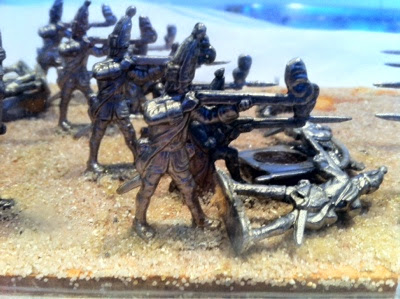I have recently been looking at rules to be used with my 28mm ECW collection which has laid in its boxes gathering dust for many years.
On the Old School list I have a few options for rules.
1. The English Civil War published by Bayonet Publications circa 1970. I bought this set around that time from a Wargame shop in East Ham which I think was called New Model Army. I used to travel all over London on Red Bus Rovers visiting various wargame shops.
These rules are attributed to Neville Dickinson and I believe where the set used for the ECW campaign in Donald Featherstones book Wargame Campaigns. Pedigree indeed.
These rules have large units consisting of 18 Muskets and 18 Pikemen with 3 Officer/Standard Bearers. These are fairly simple but have a rather more complex morale tables.
I used to use these rules with my old 20mm Minifigs figures
2. Don Featherstones ECW rules
These rules were published in the Book Lost Tales and a very similar to the other period rules published under the Wargamers Newsletter series.
These rules are simple and look to nicely reflect the period. I have not tried these but they do look promising for an Old School game
There are no units sizes specified however seperate officers are required for morale. Infantry Units of 30 or more and 3 officers would look to be the right size.
3. Pike and Shot rules by Charlie Wesencraft.
Charlie has 2 sets which are similliar, Firstly there are the ones in his First book 'Pratical Wargaming'
Charlie also published a further book 'With Pike and Musket'.
This book contains another set of rules and also includes details of the battles and the figures required to refight them,
Some of the other sets I own include:
These are the new kids on the block being published in 2014. These are a relatively simple set but having read through them look to capture the period feel very well.
Combat uses stands and 2 * d6 plus and minus a few factors scoring a 8 to hit. If you score 6 hits remove a stand. If you score less roll a D6 and score equal or less than the number of hits to remove a stand.
Melee works in a similar way with losers being pushed back the difference in hits.
Units can only be pushed back so far before they start to crumble and then rout.
The Army lists have a nice way for selecting the quality and type of troops you get by using cards with cards being drawn for each type of unit they select.
I am looking forward to giving these a go,I
Other rules for the period I own include:
And finally this dubious set co authored by yours truely some 10 years ago.
I have started re basing and refurbishing my collection on 40mm squares bases for infantry. My cavalry are going to remain on 50 by 50 bases but I will touch up the ground work.






























